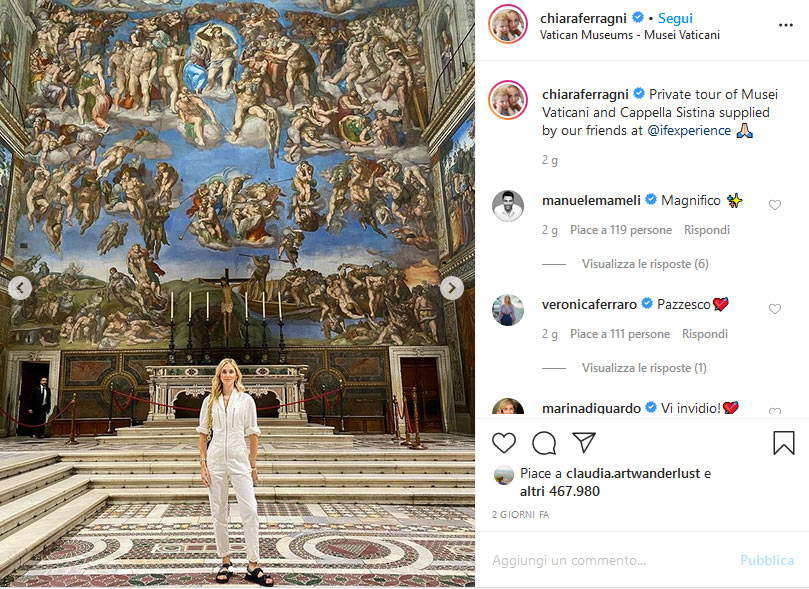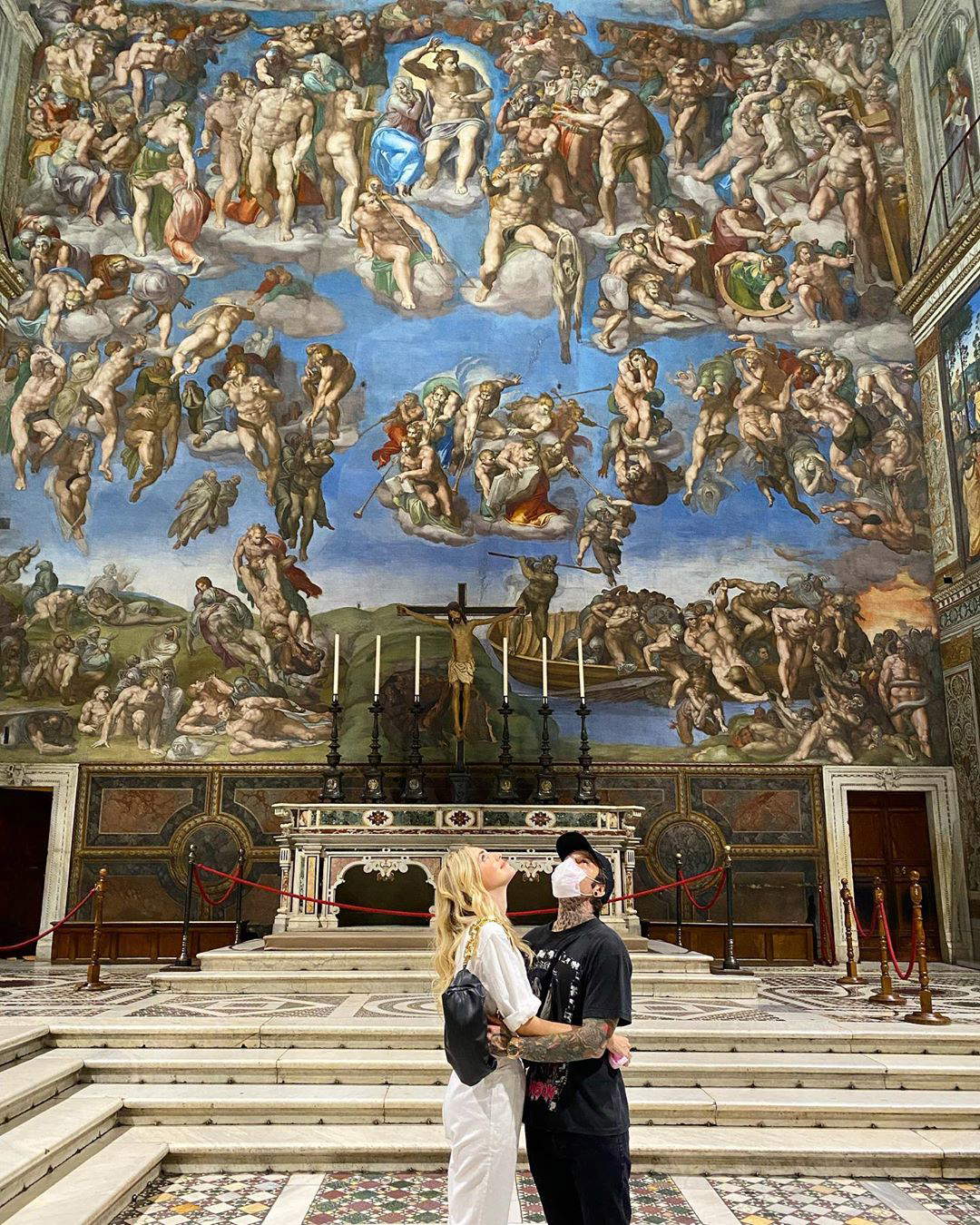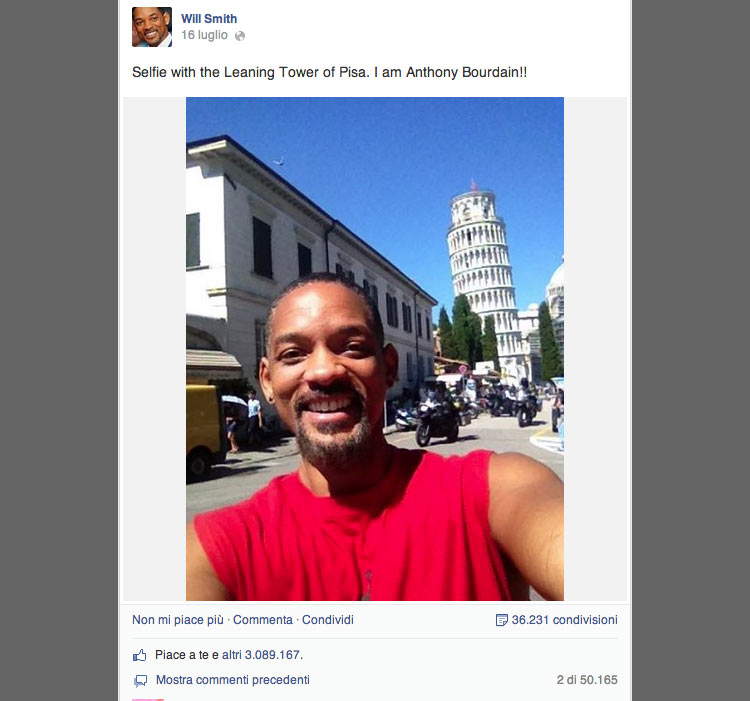These days there is a lot of talk about the photos posted on Chiara Ferragni’s Instagram profile, in which the most famous influencer in our country is portrayed in front of the Colosseum, in front of St. Peter’s, the Vatican Museums and in the Sistine Chapel. Logically, the photos did not go unnoticed, and the over 450 thousand average likes obtained per single post are an obvious confirmation of this.
A lot of controversy for a private visit with attached ritual photos, which any of us would have taken and probably posted on our social profiles if we had found ourselves in the same situation (the fee charged for a private visit is expensive but still reasonable for the proposed offer, with the possibility of being able to take photos, since during the usual visiting hours in the Sistine Chapel photos are forbidden). A practice, that of the “monumental” selfie, to which even the big stars from overseas are not immune: we remember for example 2014, when Will Smith (the Hollywood super star, former Prince of Bel Air, former Man in Black, and much more) took a nice smiling picture of himself in front of the Tower of Pisa, and in a few hours his post became more than viral, achieving a huge result, with over 3 million likes and 36 thousand shares. At the time, however, there was no scandal and no controversy: maybe it’s because we Italians have always been a bit of an outsider, maybe it’s because lately we’ve been suffering from the fascination of informal looks, but that smiling young man in a red tank top in front of the most famous tower in the world only aroused a lot of sympathy among those in the industry and others (just search the internet for press reviews from that period). And to the good peace of the Pisan promotion body, which in those years, with its “Pisa Unica Terra” communication campaign, was committed to raising interest and stimulating attention for the artistic heritage of the vast province of Pisa, which had always been crushed by the notoriety of the famous Tower.
 |
| Chiara Ferragni at the Sistine Chapel |
 |
| Chiara Ferragni at the Sistine Chapel |
 |
| Will Smith’s selfie with the Tower of Pisa. |
So here we reopen the usual debate: can influencers be useful for the promotion of art places? The writer, while being a content enthusiast, is convinced that the answer to the question is yes. However, we need to be clear from the outset: it is not enough to have a few thousand followers to be considered an interesting stakeholder in our field, not all influencers can be useful to achieve the goals set, and when choosing places and services to promote one must have a minimum of strategy and know well what results one wants to achieve.
Allowing me a digression, it is undeniable that some places, in recent years, have become popular for the general public thanks to film productions: think of Montalbano’s villages and squares, think of Matera and Basilicata after Mel Gibson’s The Passion of the Christ , think of Iceland after the Sword Throne, or even the success of Vermeer’s Girl with a Turban, which after Peter Webber’s film based on Tracy Chevalier’s novel has not only become a real celebrity, but has also completely abandoned the name by which she was conventionally referred to by scholars and the public to transform herself permanently into the Girl with a Pearl Earring, much to the chagrin of art historians. Places and works that those who are reading this article probably already knew, but which became popular after being on television: and who knows how many Americans began to dream of Italy after seeing Roman Holiday, and who knows how much that 1953 film contributed, for example, to the popularity of our Vespa overseas. And today, after more than sixty years since the release of that famous film (3 Oscars and 7 nominations), there are even specialized tours that offer novices Gregory Peck and Audrey Hepburn romantic excursions aboard the very iconic Italian motorcycle.
And so while it is true that a film can make a location famous, it is equally true that its performers can make little-known brands famous or make them trendy. In the case of Ferragni’s much-discussed posts, it is interesting to note that the public not only appreciated the “locations” of the photo shoots, but also showed great appreciation (just look at the likes obtained) for the company that organized the Roman tour to Ferragni and her husband Fedez, and also for the bed and breakfast where the Ferragnez stayed on their previous visit to Cinque Terre.
So if we want to introduce little-known locations to the general public, why should we disdain and criticize the figure of influencers? What if influencers were able to stimulate the curiosity of younger people and get them into a museum, would that be a bad thing? What if out of a hundred who perhaps enter a museum for fashion, ten want to go deeper, wouldn’t that be a win? All of this logically accompanied by policies ofad hoc opening hours and pricing , and done judiciously: there is no point, in fact, in paying an influencer to get him or her to promote the Uffizi or Pompeii, places that advertise themselves daily (just think of the thousands of photos that are taken and posted on the social profiles of thousands of visitors every day and which, at no cost to museum coffers, act as formidable international amplifiers). So might it not be effective to use these new web myths to introduce little-known places to the public?
Let us consider that just a few hundred meters from the Uffizi is the Bargello Museum, which, despite having works by Donatello, Michelangelo, Verrocchio, Giambologna, and Cellini, 14th-century frescoes from Giotto’s school, an extraordinary collection of ivories, and one of the best collections of Islamic art there is in Italy, fails to get a large enough number of visitors to justify an eight-hour visiting schedule (back in the day, in fact, it was only open half a day): this is something that makes for great sadness. So what would happen if a Will Smith, from the height of his six feet, took a selfie while toasting Michelangelo’s Bacchus?
Warning: the translation into English of the original Italian article was created using automatic tools. We undertake to review all articles, but we do not guarantee the total absence of inaccuracies in the translation due to the program. You can find the original by clicking on the ITA button. If you find any mistake,please contact us.